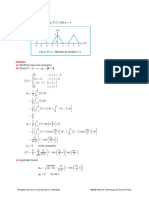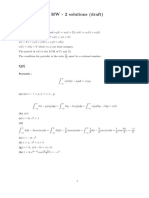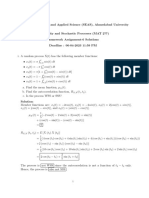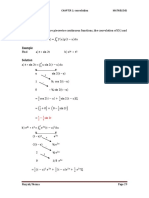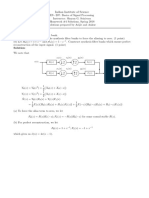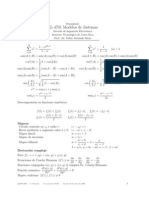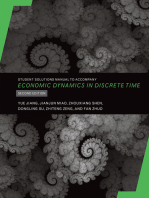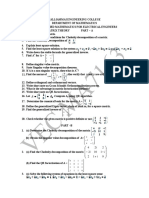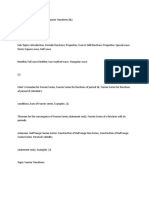Fourier Series
Fourier Series
Uploaded by
Raj EconomistCopyright:
Available Formats
Fourier Series
Fourier Series
Uploaded by
Raj EconomistCopyright
Available Formats
Share this document
Did you find this document useful?
Is this content inappropriate?
Copyright:
Available Formats
Fourier Series
Fourier Series
Uploaded by
Raj EconomistCopyright:
Available Formats
Fourier series Engineering Math
Fourier series→ representing any periodic signal as a sum of infinite sines and cosines are
known as Fourier series representation.
∞
f(t) = a0 + ∑{an cos(nω0 t) + bn sin(nωo t)}
n=1
1
Where, a0 = ∫ f(t) dt
T
T
Where, ω0 → frequency
2π
ω0 =
T
2 f(t) cos(nω0 t)dt
an = ∫
T T
2
bn = ∫ f(t) sin(nω0 t)dt
T T
Where, T → fundamental time period of periodic signal
Periodic signal → Every periodic signal repeats itself after a certain interval called
fundamental time period T, It repeats itself from −∞ to + ∞.
For every periodic signal, f(t) = f(t ± T)
T → fundamental time period
For example
f(t)
+∞ +∞
−2T −T 0 T 2T t
For this signal, f(t) = f(t + T) = f(t + 2T) = f(t − T) = f(t − 2T)
So, f(t) = f(t ± kT)
Where, k is any Non-zero integer
For Even Symmetry → when f(t) is an Even Signal. i.e. f(t) = f(−t) then −bn is zero always.
bn = 0
If f(t) = cos ωt, ⇒ bn = 0
For odd symmetry → when f(t) is an odd signal.
i. e. f(−t) = −f(t)then an is zero always
an = 0
If f(t) = sin ωt ⇒ an = 0
1. The fourier series of the function
0 −π < x ≤ 0
f(x) = {
π−x 0<x ≤π
[CE-2016]
In the interval [−π, π]
π 2 cos x cos 3x cos 5x sin x sin 2x sin 3x
f(x) = + [ 2 + 2
+ 2
+ ⋯] + [ + + +⋯]
4 π 1 3 5 1 2 3
: 080-617 66 222, info@thegateacademy.com ©Copyright reserved. Web:www.thegateacademy.com 1
m
Fourier series Engineering Math
The convergence of the above Fourier series at x = 0 gives:
1 π2
(A) ∑∞
n=1 2 =
n 16
(−1)n+1 π2
(B) ∑∞
n=1 n2
= 12
1 π2
(C) ∑∞
n=1 (2n−1)2 = 8
(−1)2n+1 π
(D) ∑∞
n=1 2n−1 = 4
[𝐀𝐧𝐬. C]
π 2 1 1
f(0) = + [1 + 2 + 2 + ⋯ ]
4 π 3 5
f(0− ) + f(0+ ) π 2 1 1
= + [1 + 2 + 2 + ⋯ ]
2 4 π 3 5
0+π−0 π 2 1 1
= + [1 + 2 + 2 + ⋯ ]
2 4 π 3 5
π π 2 1 1
− = [1 + 2 + 2 + ⋯ ]
2 4 π 3 5
π 2 1 1
= [1 + 2 + 2 + ⋯ ]
4 π 3 5
2 ∞
π 1 1 1 π2
=1+ 2+ 2+⋯ ∞ ⇒ ∑ =
8 3 5 (2n − 1)2 8
n=1
Types of Fourier series
There are 2 types of Fourier series
(1) Trigonometric Fourier series
(2) Exponential Fourier series
Important points→
(i) Spectrum of trigonometric fourier series is one sided line spectrum (Discrete spectrum)
(ii) Spectrum of exponential fourier series is two sided line spectrum
(iii) Fourier series is applicable for periodic signals only
Example
2. Consider the periodic square wave form and write Fourier series for it.
f(t)
2A
−4 −3 −2 −1 0 1 2 3 4 t
Fourier series of f(t) = a0 + ∑ an cos(nω0 t) + bn sin(nω0 t)
n=1
2π 2A 0 < t < 1
Where, ω0 = Given f(t) = {−A 1 < t < 2
T
So, time period of given signal (T) = 2
: 080-617 66 222, info@thegateacademy.com ©Copyright reserved. Web:www.thegateacademy.com 2
m
Fourier series Engineering Math
2π
∴ ω0 = =π
2
1
𝐂𝐚𝐥𝐜𝐮𝐥𝐚𝐭𝐞 , 𝐚𝟎 → a0 = T ∫T f(t)dt
1 1 2
a0 = [∫ 2A dt + ∫ (−A) dt]
2 0 1
1 1 A
a0 = [2A (t)10 + (−A)(t)12 ] = [2A − A] =
2 2 2
2 f (t) cos(nω0 t)dt ω0 = π
𝐂𝐚𝐥𝐜𝐮𝐥𝐚𝐭𝐞, 𝐚𝐧 → an = ∫T
T
2 1 2
∴ an = [∫ 2A cos(nπt)dt + ∫ (−A) sin(nπt)dt]
2 0 1
1 2
an = 2A ∫ cos(nπt) dt − A ∫ sin(nπt)dt
0 1
2A A
an = {sin(nπt)}10 − {sin(nπt)}12
nπ nπ
an = 0 Since, sin(2nπ) = sin (nπ) = sin(0) = 0
Note: Even, After looking at waveform only, we can say an = 0 because the waveform have
odd symmetry.
2
𝐂𝐚𝐥𝐜𝐮𝐥𝐚𝐭𝐞, 𝐛𝐧 → bn = T ∫T f(t) sin(nω0 t)dt ω0 = π & T = 2
2 1 2
bn = [∫ 2A sin(nπt)dt + ∫ (−A) sin(nπt)dt]
2 0 1
1 2
1 −1
bn = 2A {− cos(nπt)} − A { cos(nπt)}
nπ 0 nπ 1
−2A A
bn = {cos(nπ) − cos 0} + {cos(2nπ) − cos(nπ)}
nπ nπ
−2A A
bn = {(−1)n − 1} + {1 − (−1)n }
nπ nπ
A
bn = [1 − (−1)n + 2 − 2(−1)n ]
nπ
A 3A
∴ bn = [3 − 3(−1)n ] = {1 − (−1)n }
nπ nπ
6A
So, bn = 0 when n is Even and bn = when n is odd.
nπ
A 6A
Fourier series → f(t) = ∞
+ ∑n=1 0 + sin(nπt)
2 nπ
Only n is odd
∞
A 6A
f(t) = + ∑ sin(2n − 1)πt
2 (2n − 1)π
n=1
: 080-617 66 222, info@thegateacademy.com ©Copyright reserved. Web:www.thegateacademy.com 3
m
You might also like
- Fourier Representation of Signals: Tutorial ProblemsDocument62 pagesFourier Representation of Signals: Tutorial ProblemsMarcel HuberNo ratings yet
- Chapter6 SolDocument3 pagesChapter6 SolmoosemeatNo ratings yet
- Section 4.1: General Theory of NTH Order Linear EquationsDocument2 pagesSection 4.1: General Theory of NTH Order Linear EquationsJuan AriasNo ratings yet
- 1.7 Fourier Integral:: LectureDocument13 pages1.7 Fourier Integral:: Lectureاطياف حامد محمدNo ratings yet
- The Fourier Series EditedDocument46 pagesThe Fourier Series EditedSarah HillmanNo ratings yet
- Supch16 PDFDocument14 pagesSupch16 PDFvampakkNo ratings yet
- Week 5 - Signal Representations Using Fourier Series Activity 1 Part 1Document4 pagesWeek 5 - Signal Representations Using Fourier Series Activity 1 Part 1siarwafaNo ratings yet
- Problem-01 Ch Eleven아러류Document2 pagesProblem-01 Ch Eleven아러류김경동No ratings yet
- DSP4 Fourier Series - UnlockedDocument46 pagesDSP4 Fourier Series - UnlockedluisperikoNo ratings yet
- HB - Haykin - Signals and Systems 2nd Ed PDFDocument634 pagesHB - Haykin - Signals and Systems 2nd Ed PDFValentin GyurovNo ratings yet
- Signal Solutiopn AkmsDocument634 pagesSignal Solutiopn AkmsAnanthakrishnaNo ratings yet
- Periodic Functions and Fourier SeriesDocument10 pagesPeriodic Functions and Fourier SeriesAli QpskNo ratings yet
- Formulario Transformadas Laplace y EDOODocument1 pageFormulario Transformadas Laplace y EDOOpotasio hNo ratings yet
- 9781107059320-SOLUTIONS Essential Digital SolutionsDocument47 pages9781107059320-SOLUTIONS Essential Digital SolutionsGulrez MNo ratings yet
- Mit18 03scf11 ps5 s22sDocument3 pagesMit18 03scf11 ps5 s22skevin iyeseNo ratings yet
- 01b-Fourier Series RevisionDocument37 pages01b-Fourier Series RevisionGeorges YoussefNo ratings yet
- Tutorial 1 - FOURIER - WITH SOLUTION 2020 PDFDocument25 pagesTutorial 1 - FOURIER - WITH SOLUTION 2020 PDFDebra UngNo ratings yet
- ELEN3012 - 2020 Part 1Document6 pagesELEN3012 - 2020 Part 1Bongani MofokengNo ratings yet
- Homework 10Document5 pagesHomework 10Khalil UllahNo ratings yet
- HW - 2 Solutions (Draft)Document6 pagesHW - 2 Solutions (Draft)Hamid RasulNo ratings yet
- Lab 10 MTH240 W2023 SolutionsDocument7 pagesLab 10 MTH240 W2023 SolutionsJoseph GuirguisNo ratings yet
- ELEN3012 - 2020 Part 2Document7 pagesELEN3012 - 2020 Part 2Bongani MofokengNo ratings yet
- Laplace - Transform - 1Document11 pagesLaplace - Transform - 1alialtin6263No ratings yet
- 1.9 RMS Values and Parseval's IdentitiesDocument4 pages1.9 RMS Values and Parseval's IdentitiesMajety S LskshmiNo ratings yet
- HW1 SolutionDocument3 pagesHW1 Solution박천우No ratings yet
- Homework Assignment 6Document8 pagesHomework Assignment 6pniyati508No ratings yet
- UMGC MATH 241 Hw6 - Chapter 16aDocument10 pagesUMGC MATH 241 Hw6 - Chapter 16abxcknuggetsNo ratings yet
- Signals & Systems - Chapter 3: Je Je e e e A T XDocument9 pagesSignals & Systems - Chapter 3: Je Je e e e A T XAlgerian AissaouiNo ratings yet
- Problem Solutions For Chapter 7: j2 FT j2 FTDocument18 pagesProblem Solutions For Chapter 7: j2 FT j2 FTapi-19870706No ratings yet
- Math 202 PS6 SolutionsDocument8 pagesMath 202 PS6 SolutionsasdasdasdNo ratings yet
- DC Notes III UnitDocument29 pagesDC Notes III UnitRVijayaDurgaNo ratings yet
- Assignment 1/ Class Test 1: 5. (MCQ Online) (Online Upload)Document8 pagesAssignment 1/ Class Test 1: 5. (MCQ Online) (Online Upload)Kgotso KgengweNo ratings yet
- T +1 1 T 0 T +1 0 T 1: Encontrar La Serie de Fourier para La Función F (T) Definida Por F (T)Document3 pagesT +1 1 T 0 T +1 0 T 1: Encontrar La Serie de Fourier para La Función F (T) Definida Por F (T)Danny LeónNo ratings yet
- Solutions For TMA4170 Fourier Analysis: N n+1 N NDocument3 pagesSolutions For TMA4170 Fourier Analysis: N n+1 N NMelih EryiğitNo ratings yet
- Stochastic Calculus Final Exam With SolutionsDocument11 pagesStochastic Calculus Final Exam With SolutionsTrbvm100% (1)
- Week6 CHAPTER 1: Convolution MAT485/565Document4 pagesWeek6 CHAPTER 1: Convolution MAT485/565qistinaNo ratings yet
- EECE 301 Discussion 06 - FT ExamplesDocument13 pagesEECE 301 Discussion 06 - FT ExamplesFatmir KelmendiNo ratings yet
- Practice Questions: Terry Lee Advanced MathematicsDocument3 pagesPractice Questions: Terry Lee Advanced MathematicsEren SevinceNo ratings yet
- 26 - HPW 13 Ism 15 IDocument40 pages26 - HPW 13 Ism 15 IHARRY HINGNo ratings yet
- Differential and Integral Calculus 2 - Homework 2 SolutionDocument5 pagesDifferential and Integral Calculus 2 - Homework 2 SolutionDominikNo ratings yet
- Emailing مسائل محلولةDocument17 pagesEmailing مسائل محلولةhend MohamedNo ratings yet
- Ecs Dif ParcialesDocument3 pagesEcs Dif ParcialesLizz CardenasNo ratings yet
- Ordinary Differential Equations - Solution ManualDocument176 pagesOrdinary Differential Equations - Solution Manualrlewis120% (1)
- EL-4701 Modelos de Sistemas: FormularioDocument9 pagesEL-4701 Modelos de Sistemas: FormularioEmmanuel AcostaNo ratings yet
- HW 5 SolDocument4 pagesHW 5 SolGonzalo SaavedraNo ratings yet
- Homework-1 With Solutions-Fall 2020Document7 pagesHomework-1 With Solutions-Fall 2020AMNA SAMINo ratings yet
- HW1 SolutionDocument3 pagesHW1 SolutionZim ShahNo ratings yet
- Trabajo Domiciliario de Matematica V: Taquiri Mendez Edgar Kevin 20150297C 7 de Julio de 2018Document6 pagesTrabajo Domiciliario de Matematica V: Taquiri Mendez Edgar Kevin 20150297C 7 de Julio de 2018Taquiri Mendez EdgarNo ratings yet
- ECE316H1 - 20201 - 641586556718ECE316 Problem Set Solutions Merged-20Document79 pagesECE316H1 - 20201 - 641586556718ECE316 Problem Set Solutions Merged-20Vama DaveNo ratings yet
- Math 328 Module 1 Fourier SeriesDocument26 pagesMath 328 Module 1 Fourier SeriesMelchor Jaramilla OronosNo ratings yet
- hw2 SolDocument7 pageshw2 Sollicodo9896No ratings yet
- Lect4 PDFDocument15 pagesLect4 PDFcantor5No ratings yet
- 1T4: Some Basic Mathematics: Xavier SerraDocument15 pages1T4: Some Basic Mathematics: Xavier Serrajabeur rahmaNo ratings yet
- Sol3 2018Document6 pagesSol3 2018JacksonNo ratings yet
- Population Logistics Chemical EthanolDocument8 pagesPopulation Logistics Chemical EthanolTuling, Jose Jr., D.No ratings yet
- Math 677. Fall 2009. Homework #3 SolutionsDocument3 pagesMath 677. Fall 2009. Homework #3 SolutionsRodrigo KostaNo ratings yet
- f (t) =t ,−π ≤t≤π: 1) Encuentre la serie de Fourier exponencial de la siguiente funciónDocument9 pagesf (t) =t ,−π ≤t≤π: 1) Encuentre la serie de Fourier exponencial de la siguiente funciónMarco AguirreNo ratings yet
- Matek 1 - I Made Dwi Andika S. (F1B018026)Document26 pagesMatek 1 - I Made Dwi Andika S. (F1B018026)I Made Dwi AndikaNo ratings yet
- Student Solutions Manual to Accompany Economic Dynamics in Discrete Time, second editionFrom EverandStudent Solutions Manual to Accompany Economic Dynamics in Discrete Time, second editionRating: 4.5 out of 5 stars4.5/5 (2)
- MA7163-Applied Mathematics For Electrical Engineers QB PDFDocument11 pagesMA7163-Applied Mathematics For Electrical Engineers QB PDFNITHYAPREMININo ratings yet
- Mech Engg 2-1 CS & Syllabus - UG - R20Document22 pagesMech Engg 2-1 CS & Syllabus - UG - R20Syam RajuNo ratings yet
- Experimental Electronic Music Devices Employing Walsh FunctionsDocument6 pagesExperimental Electronic Music Devices Employing Walsh FunctionsCatalin MoiseNo ratings yet
- CHAPTER 4 - Fourier SeriesDocument14 pagesCHAPTER 4 - Fourier SeriesCHEONG YONG XUAN STUDENTNo ratings yet
- Chapter 6 NotesDocument13 pagesChapter 6 NotesalariekiraNo ratings yet
- Fourier Series Notes PDFDocument39 pagesFourier Series Notes PDFsudarshan poojaryNo ratings yet
- Complex Engineering Problem Signals and Systems EE-231LDocument11 pagesComplex Engineering Problem Signals and Systems EE-231LSaadatIrfanNo ratings yet
- 7 1 Fourier SeriesDocument48 pages7 1 Fourier SeriesMinh Huynh100% (1)
- Signal System 50 Most Important MCQs With Solution PDFDocument15 pagesSignal System 50 Most Important MCQs With Solution PDFSudheer naikNo ratings yet
- 21mat31 Model Question Paper VTU 3rd Sem 21 SchemeDocument4 pages21mat31 Model Question Paper VTU 3rd Sem 21 Schemeyoung flier0% (1)
- Laboratory 7 - Fourier Series Representation of Continuous Time Periodic SignalsDocument12 pagesLaboratory 7 - Fourier Series Representation of Continuous Time Periodic SignalsOsama AlqahtaniNo ratings yet
- Periodic Functions and Fourier SeriesDocument10 pagesPeriodic Functions and Fourier SeriesAli QpskNo ratings yet
- Signals & SystemsDocument19 pagesSignals & SystemsManish KushwahaNo ratings yet
- 7 Fourier SeriesDocument43 pages7 Fourier SeriesMuhammad FawwazNo ratings yet
- M III Question BankDocument34 pagesM III Question BankHemamalini SurehbabuNo ratings yet
- Frequency Analysis PBLDocument15 pagesFrequency Analysis PBLDr. S. DasNo ratings yet
- MA7163-Applied Mathematics For Electrical EngineersDocument11 pagesMA7163-Applied Mathematics For Electrical Engineersantoabi100% (2)
- EA201MM2 03a Trigo-Series ReviewDocument52 pagesEA201MM2 03a Trigo-Series ReviewSeanNo ratings yet
- Transforms and Partial Differential Equation Questions Notes of m3, 3rd Semester NotesDocument16 pagesTransforms and Partial Differential Equation Questions Notes of m3, 3rd Semester NotesBalaji ShanmugamNo ratings yet
- Analog Updated W2Document7 pagesAnalog Updated W2Subhajit BhattacharyyaNo ratings yet
- 3rd Sem SyllabusDocument28 pages3rd Sem SyllabusRASHMI H CNo ratings yet
- 1-dsp SBT PDFDocument68 pages1-dsp SBT PDFNeelabro KonarNo ratings yet
- Fourier Transform: MATHS (Hons), Second YEARDocument120 pagesFourier Transform: MATHS (Hons), Second YEARmanish chauhanNo ratings yet
- Fourier Representation of Signals and LTI SystemsDocument45 pagesFourier Representation of Signals and LTI SystemsJazmi MukhtarNo ratings yet
- Slide 2 Discrete Time SignalsDocument100 pagesSlide 2 Discrete Time SignalsmusaNo ratings yet
- Analysis Type Ventameter by Anand RoyDocument6 pagesAnalysis Type Ventameter by Anand RoySapat DasNo ratings yet
- SYDE 252 Linear Systems and Signals Fall 2005 Professor Ed Jernigan Systems Design Engineering University of WaterlooDocument70 pagesSYDE 252 Linear Systems and Signals Fall 2005 Professor Ed Jernigan Systems Design Engineering University of Waterloocartoon_nateNo ratings yet
- Assignment 1Document5 pagesAssignment 1Saarthi Sood100% (1)
- EEEN 202 Lecture Notes 06Document32 pagesEEEN 202 Lecture Notes 06blue educationNo ratings yet
- Analog Communication: Dr. CH - Srinivasa Rao, JNTUK, VizianagaramDocument78 pagesAnalog Communication: Dr. CH - Srinivasa Rao, JNTUK, VizianagaramVSNo ratings yet







